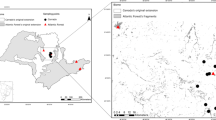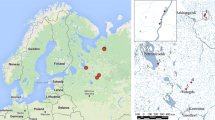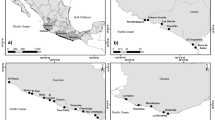Abstract
Tank bromeliads (Bromeliaceae) often occur in high densities in the Neotropics and represent a key freshwater habitat in montane forests, housing quite complex invertebrate communities. We tested the extent to which there are species richness–altitude, richness–environment, richness–size, richness–habitat complexity and richness–isolation relationships for the aquatic invertebrate communities from 157 bromeliads in Cusuco National Park, Honduras. We found that invertebrate species richness and abundance correlated most strongly, and positively, with habitat size, which accounted for about a third of the variance in both. Apart from bromeliad size (equivalent of the species–area relationship), we found remarkably little evidence of classic biogeographic and ecological relationships with species richness in this system. Community composition correlated with altitude, bromeliad size and position, though less than 20% of the variation was accounted for by the tested variables. The turnover component of dissimilarity between the communities correlated with altitude, while the nestedness-resultant component was related to bromeliad size. The unexplained variance could reflect a large stochastic component in the system, associated with the ephemerality of the habitat patches (both the plants themselves and the fluctuations in their water content) and stochasticity due to the dispersal dynamics in the system. We conclude that there is a small contribution of classic biogeographic factors to the diversity and community composition of aquatic invertebrates communities in bromeliads. This may be due to the highly dynamic nature of this system, with small patch sizes and high emigration rates. The patterns may mostly be driven by factors affecting colonisation success.


Similar content being viewed by others
References
Armbruster, P., R. A. Hutchinson & P. Cotgreave, 2002. Factors influencing community structure in a South American tank bromeliad fauna. Oikos 96: 225–234.
Baselga, A., 2010. Partitioning the turnover and nestedness components of beta diversity. Global Ecology and Biogeography 19: 134–143.
Benzing, D. H., 2000. Bromeliaceae: Profile of an Adaptive Radiation. Cambridge University Press, New York, NY.
Binckley, C. A. & W. J. Resetarits, 2005. Habitat selection determines abundance, richness and species composition of beetles in aquatic communities. Biology Letters 1: 370–374.
Brouard, O., A. H. Le Jeune, C. Leroy, R. Cereghino, O. Roux, L. Pelozuelo, A. Dejean, B. Corbara & J. F. Carrias, 2011. Are algae relevant to the detritus-based food web in tank-bromeliads? PLoS ONE 6: e20129. doi:10.1371/journal.pone.0020129.
Brown, J. H. & A. Kodric-Brown, 1977. Turnover rates in insular biogeography—effect of immigration on extinction. Ecology 58: 445–449.
Cereghino, R., C. Leroy, J. F. Carrias, L. Pelozuelo, C. Segura, C. Bosc, A. Dejean & B. Corbara, 2011. Ant–plant mutualisms promote functional diversity in phytotelm communities. Functional Ecology 25: 954–963.
Cotgreave, P., M. J. Hill & D. A. J. Middleton, 1993. The relationship between body-size and population-size in bromeliad tank faunas. Biological Journal of the Linnean Society 49: 367–380.
De Meester, L., A. Gomez, B. Okamura & K. Schwenk, 2002. The monopolization hypothesis and the dispersal–gene flow paradox in aquatic organisms. Acta Oecologica-International Journal of Ecology 23: 121–135.
Dézerald O., T. Stanislas, C. Leroy, J. Carrias, B. Corbara, A. Dejean & R. Céréghino, 2014. Environmental determinants of macroinvertebrate diversity in small water bodies: insights from tank-bromeliads. Hydrobiologia 723: 77–86.
Dodson, S., 1992. Predicting crustacean zooplankton species richness. Limnology and Oceanography 37: 848–856.
Field, R. & P. R. Long, 2007. Cusuco National Park, Honduras: Ecology of a Meso-American Cloud Forest. Operation Wallacea Ltd, Old Bolingbroke.
Field, R., B. A. Hawkins, H. V. Cornell, D. J. Currie, J. A. F. Diniz-Filho, J.-F. Guégan, D. M. Kaufman, J. T. Kerr, G. G. Mittelbach, T. Oberdorff, E. M. O’Brien & J. R. G. Turner, 2009. Spatial species-richness gradients across scales: a meta-analysis. Journal of Biogeography 36: 132–147.
Fish, D., 1976. Structure and composition of the aquatic invertebrate community inhabiting epiphytic bromeliads in South Florida and the discovery of an insectivorous bromeliad. PhD dissertation. University of Florida.
Frank, J. H. & L. P. Lounibos, 1983. Phytotelmata: Terrestrial Plants as Hosts for Aquatic Insect Communities. Plexus, Medford, NJ.
Frank, J. H. & L. P. Lounibos, 2009. Insects and allies associated with bromeliads: a review. Terrestrial Arthropod Reviews 1: 125–153.
Frank, J. H., S. Sreenivasan, P. J. Benshoff, M. A. Deyrup, G. B. Edwards, S. E. Halbert, A. B. Hamon, M. D. Lowman, E. L. Mockford, R. H. Scheffrahn, G. J. Steck, M. C. Thomas, T. J. Walker & W. C. Welbourne, 2004. Invertebrate animals extracted from native Tillandsia (Bromeliales: Bromeliaceae) in Sarasota County, Florida. Florida Entomologist 87: 176–185.
Gilbert, B., D. S. Srivastava & K. R. Kirby, 2008. Niche partitioning at multiple scales facilitates coexistence among mosquito larvae. Oikos 117: 944–950.
Greeney, H. F., 2001. The insects of plant-held waters: a review and bibliography. Journal of Tropical Ecology 17: 241–260.
Grytnes, J. A. & C. M. McCain, 2007. Elevational patterns in species richness. In Levin, S. (ed.), Encyclopedia of Biodiversity. Elsevier, Inc., Oxford.
Hortal, J., K. A. Triantis, S. Meiri, E. Thebault & S. Sfenthourakis, 2009. Island species richness increases with habitat diversity. American Naturalist 174: E205–E217.
Jabiol, J., B. Corbara, A. Dejean & R. Cereghino, 2009. Structure of aquatic insect communities in tank-bromeliads in an East-Amazonian rainforest in French Guiana. Forest Ecology and Management 257: 351–360.
Jocque, M. & J. Kolby, 2012. Acidity of tank bromeliad water in a cloud forest, Cusuco National Park, Honduras. International Journal of Plant Physiology and Biochemistry 4: 59–70.
Jocque, M., A. Kernahan, A. Nobes, C. Willians & R. Field, 2010a. How effective are non-destructive sampling methods to assess aquatic invertebrate diversity in bromeliads? Hydrobiologia 649: 293–300.
Jocque, M., R. Field, L. Brendonck & L. De Meester, 2010b. Climatic control of dispersal–ecological specialization trade-offs: a metacommunity process at the heart of the latitudinal diversity gradient? Global Ecology and Biogeography 19: 244–252.
Karger, D. N., J. Kluge, T. Kromer, A. Hemp, M. Lehnert & M. Kessler, 2011. The effect of area on local and regional elevational patterns of species richness. Journal of Biogeography 38: 1177–1185.
Kitching, R. L., 2000. Food Webs and Container Habitats: The Natural History and Ecology of Phytotelmata. Cambridge University Press, Cambridge.
Laessle, A. M., 1961. A micro-limnological study of Jamaican bromeliads. Ecology 42: 499–517.
Leibold, M. A., M. Holyoak, N. Mouquet, P. Amarasekare, J. M. Chase, M. F. Hoopes, R. D. Holt, J. B. Shurin, R. Law, D. Tilman, M. Loreau & A. Gonzalez, 2004. The meta-community concept: a framework for multi-scale community ecology. Ecology Letters 7: 601–613.
Little, T. & P. D. N. Hebert, 1996. Endemism and ecological islands: the ostracods from Jamaican bromeliads. Freshwater Biology 36: 327–338.
Lopez, L. C. S., D. A. Goncalves, A. Mantovani & R. I. Rios, 2002. Bromeliad ostracods pass through amphibian (Scinaxax perpusillus) and mammalian guts alive. Hydrobiologia 485: 209–211.
MacArthur, R. H. & E. O. Wilson, 1967. The Theory of Island Biogeography. Princeton University Press, Princeton, NJ.
Maguire, B., 1971. Phytotelmata: biota and community structure determination in plant-held waters. Annual Review of Ecology and Systematics 2: 439–464.
McCain, C. M., 2007. Area and mammalian elevational diversity. Ecology 88: 76–86.
Mendes, H. F., T. Andersen & M. Jocque, 2011. A new species of Polypedilum Kieffer from bromeliads in Parque Nacional Cusuco, Honduras (Chironomidae: Chironominae). Zootaxa 3062: 46–54.
Montero, G., C. Feruglio & I. M. Barberis, 2010. The phytotelmata and foliage macrofauna assemblages of a bromeliad species in different habitats and seasons. Insect Conservation and Diversity 3: 92–201.
Ngai, J. T., K. R. Kirby, B. Gilbert, B. M. Starzomski, A. D. J. Pelletier & J. C. R. Conner, 2008. The impact of land-use change on larval insect communities: testing the role of habitat elements in conservation. Ecoscience 15: 160–168.
Picado, C., 1913. Les Bromeliacees Epiphytes. Bulletin Scientifique Tome 47: 216–360.
R Studio, 2012. RStudio: Integrated Development Environment for R (Version 0.96.122) [Computer Software]. RStudio, Boston.
Rahbek, C., 1995. The elevational gradient of species richness—a uniform pattern. Ecography 18: 200–205.
Rahbek, C., 2005. The role of spatial scale and the perception of large-scale species-richness patterns. Ecology Letters 8: 224–239.
Rangel, T., J. A. F. Diniz-Filho & L. M. Bini, 2006. Towards an integrated computational tool for spatial analysis in macroecology and biogeography. Global Ecology and Biogeography 15: 321–327.
Reich, A., J. J. Ewel, N. M. Nadkarni, T. Dawson & R. D. Evans, 2003. Nitrogen isotope ratios shift with plant size in tropical bromeliads. Oecologia 137: 587–590.
Richardson, B. A., 1999. The bromeliad microcosm and the assessment of faunal diversity in a Neotropical forest. Biotropica 31: 321–336.
Rohde, K., 1992. Latitudinal gradients in species diversity—the search for the primary cause. Oikos 65: 514–527.
Srivastava, D. S., 2006. Habitat structure, trophic structure and ecosystem function: interactive effects in a bromeliad–insect community. Oecologia 149: 493–504.
Srivastava, D. S. & J. H. Lawton, 1998. Why more productive sites have more species: an experimental test of theory using tree-hole communities. American Naturalist 152: 510–529.
Srivastava, D. S., J. Kolasa, J. Bengtsson, A. Gonzalez, S. P. Lawler, T. E. Miller, P. Munguia, T. Romanuk, D. C. Schneider & M. K. Trzcinski, 2004. Are natural microcosms useful model systems for ecology? Trends in Ecology & Evolution 19: 379–384.
Srivastava, D. S., M. K. Trzcinski, B. A. Richardson & B. Gilbert, 2008. Why are predators more sensitive to habitat size than their prey? Insights from bromeliad insect food webs. American Naturalist 172: 761–771.
StatSoft, Inc., 2012. STATISTICA (data analysis software system), version 11. www.statsoft.com.
Sugden, A. M. & R. J. Robins, 1979. Aspects of the ecology of vascular epiphytes in Colombian cloud forests. 1. Distribution of the epiphytic flora. Biotropica 11: 173–188.
ter Braak, C. J. F. & P. Šmilauer, 2002. CANOCO Reference Manual and CanoDraw for Windows User’s Guide: Software for Canonical Community Ordination (version 4.5). Microcomputer Power, Ithaca NY.
Acknowledgments
We would like to thank the people living around Cusuco National Park for collaboration and guidance on the numerous excursions into the forest, namely those from Buenos Aires, Santo Tomas and Tierra Santa. Many thanks also to Operation Wallacea for supporting the research, and also to the enthusiastic volunteers of Operation Wallacea that assisted with data collection in the field, in particular J. Casteels, A. Belen, A. Kernahan, A. Nobes, J. Kolby and C. Willans. Merlijn Jocque was supported by a “Back to Belgium” grant from the Belgian Science Policy (BELSPO) issued in 2010.
Author information
Authors and Affiliations
Corresponding author
Additional information
Handling editor: B. Oertli
Rights and permissions
About this article
Cite this article
Jocque, M., Field, R. Aquatic invertebrate communities in tank bromeliads: how well do classic ecological patterns apply?. Hydrobiologia 730, 153–166 (2014). https://doi.org/10.1007/s10750-014-1831-7
Received:
Revised:
Accepted:
Published:
Issue Date:
DOI: https://doi.org/10.1007/s10750-014-1831-7




